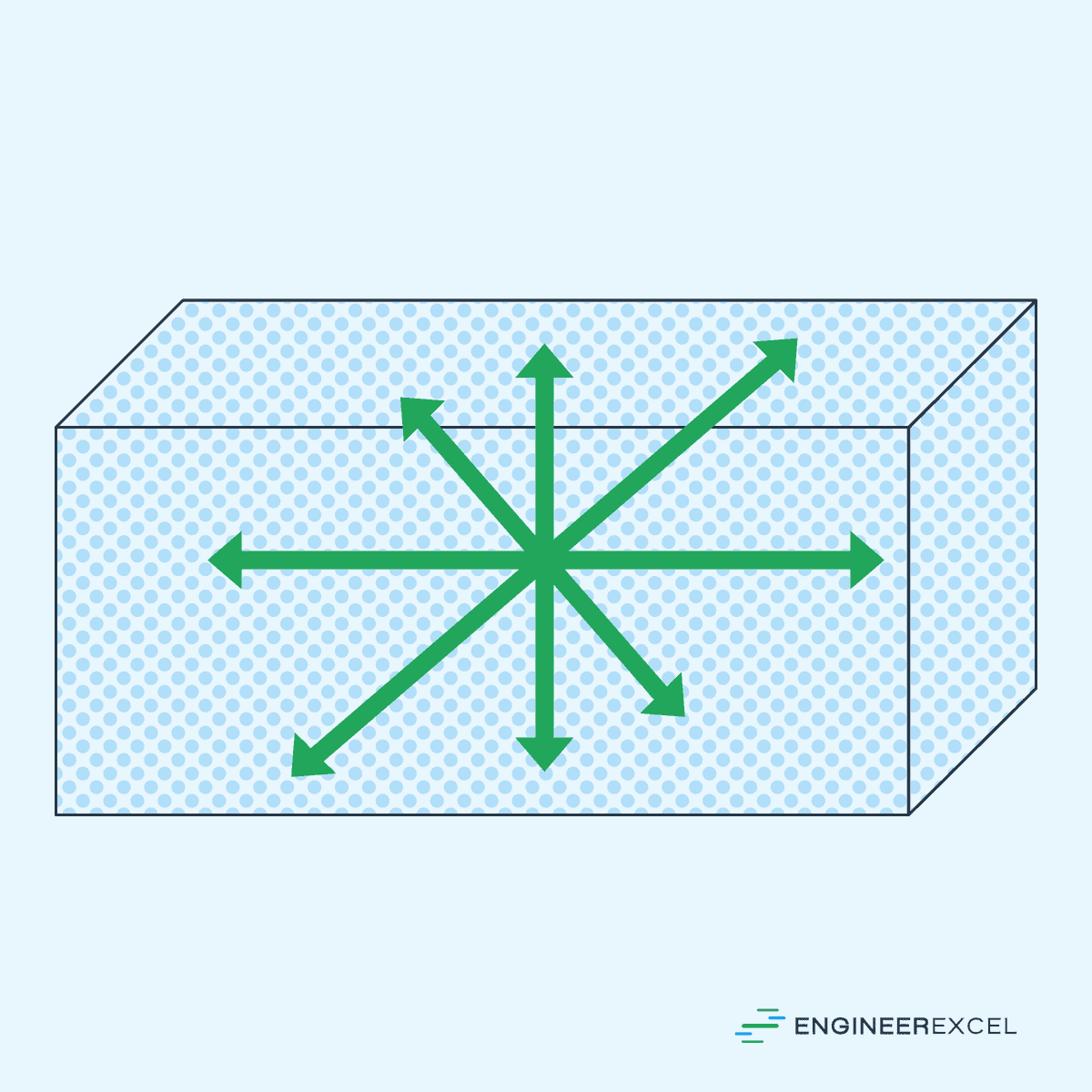Isotropic materials are substances whose properties are uniform in all directions. This means that their mechanical and thermal properties, such as elasticity and thermal conductivity, are the same regardless of the direction in which they are measured.

In this article, we delve into the properties of isotropic materials, their diverse applications, and the design considerations that come into play when working with these materials.
What are Isotropic Materials
Isotropic materials refer to materials that exhibit uniform properties in all directions. The term “isotropic” derives from the Greek words isos, meaning equal, and tropos, meaning way. This homogeneity means that when measured in different directions, physical properties such as elasticity, thermal expansion, and electrical conductivity remain consistent.


Elevate Your Engineering With Excel
Advance in Excel with engineering-focused training that equips you with the skills to streamline projects and accelerate your career.
In contrast, anisotropic materials differ in their properties when measured along different axes. This can be due to inherent structural differences or the arrangement of components within the material.
Isotropic materials are advantageous in applications where uniformity and predictability are critical. Their uniform nature allows for the removal of complexities that arise with anisotropic materials, which require different considerations for different directional properties.
Furthermore, isotropic materials can simplify the calculations needed for engineering solutions, as the need to account for properties varying with direction is eliminated. They serve as a fundamental class of materials in areas such as civil engineering, mechanical design, and aerospace engineering, where structural integrity and reliability are vital.
Properties of Isotropic Materials
The homogeneity of isotropic materials is witnessed in their mechanical, thermal, and optical behaviors.
Mechanical Properties
In isotropic materials, mechanical properties such as elasticity, plasticity, and hardness are consistent regardless of measuring direction. They exhibit a single modulus of elasticity, denoting that the response to stress is the same if applied from any orientation. Materials such as iron, when present in a polycrystalline form with randomly oriented grains, demonstrate isotropic mechanical properties.
Thermal Properties
Thermal expansion and conductivity in isotropic materials remain uniform across all directions. This means that if an isotropic material is subjected to a temperature change, it expands or contracts uniformly. Additionally, heat flows at an equal rate in every direction, which simplifies thermal analysis for engineering applications.
Optical Properties
Isotropic materials also have consistent optical properties, including a uniform refractive index. This leads to light propagating at the same velocity regardless of the light’s direction of travel through the material. An example includes glasses and certain crystals, such as those from the isometric crystal system, which break light equally in every direction.
Examples of Isotropic Materials
Metals
Metals like copper, aluminum, and steel are generally considered isotropic because they exhibit consistent material properties in all directions. This isotropic behavior is primarily due to the uniform, crystalline structure of metals on a large scale, especially in polycrystalline metals with randomly oriented grains. The random orientation of grains in polycrystalline metals cancels out any anisotropy at the individual grain level, resulting in overall isotropic properties.

However, there are exceptions to this rule. For instance, single crystal metals often display anisotropic behavior, meaning their mechanical properties can vary with direction. Tungsten, a cubic metal, stands out as an exception among single crystal systems, as it demonstrates isotropic properties.
It is important to note that the isotropy of metals is generally an approximation, as it may not hold true at smaller scales or in single crystals.
Glass
Glass is generally considered isotropic because the molecular structure of glass lacks the long-range order found in crystalline materials, resulting in the absence of preferred directions for the transmission of light, heat, or sound. As a result, glass exhibits similar physical and optical properties regardless of the direction in which it is measured.
However, there are exceptions to the isotropic nature of glass. Some types of glass, such as tempered or annealed glass, may exhibit slight variations in properties due to the manufacturing process or the introduction of stress during cooling. Additionally, certain specialty glasses, such as those used in polarizing filters or optical applications, can be engineered to exhibit anisotropic properties for specific purposes.
Plastics
Plastics are generally considered to be isotropic materials due to the random arrangement of polymer chains within the material, which leads to uniform properties throughout. The amorphous structure of most plastics also contributes to their isotropic nature, as there are no long-range ordered patterns that would cause directional variations in properties.
However, some plastics, particularly those with a crystalline structure, can exhibit anisotropic behavior. Additionally, the processing and manufacturing methods used can introduce anisotropy in plastics, such as through orientation of polymer chains during molding or extrusion processes.
Applications of Isotropic Materials
Construction and Manufacturing
In construction and manufacturing, isotropic materials are favored for their predictable characteristics. They provide uniform strength and deformation across all axes. For example, concrete often assumes isotropic behavior and is widely used in structural applications due to its homogeneous mixture providing equal properties in all directions.
In the production of metals, isotropic materials minimize anisotropic weaknesses such as directional cracking or shearing. Manufacturers use isotropic steels and aluminum in automotive and aerospace industries to ensure components can withstand forces from multiple directions without a higher risk of failure.
Optical Devices
For optical devices, the isotropic nature of certain materials means that light properties, such as refraction and dispersion, remain consistent, irrespective of the light’s angle of entry. Materials like isotropic glass lenses provide a stable optical medium, ensuring that images or signals are not distorted by directional variances in the material.
Isotropic metamaterials have shown potential in creating efficient light-bending devices, such as Huygens’ surfaces, which are used to refract light at various wavelengths with low reflection and complete phase control.
Electronics
In electronics, isotropic materials are used to ensure that electrical properties do not vary with the direction of electric field application. For example, isotropic dielectric materials are critical for capacitors and insulators where a consistent dielectric response is necessary for reliable operation.
Semiconductor substrates, often relying on isotropic characteristics, ensure consistent electronic behaviors in microchips and printed circuit boards. Also, isotropic materials in electronics are necessary for the robust performance of electromagnetic shielding and waveguides, where uniformity in material performance ensures circuit integrity.
